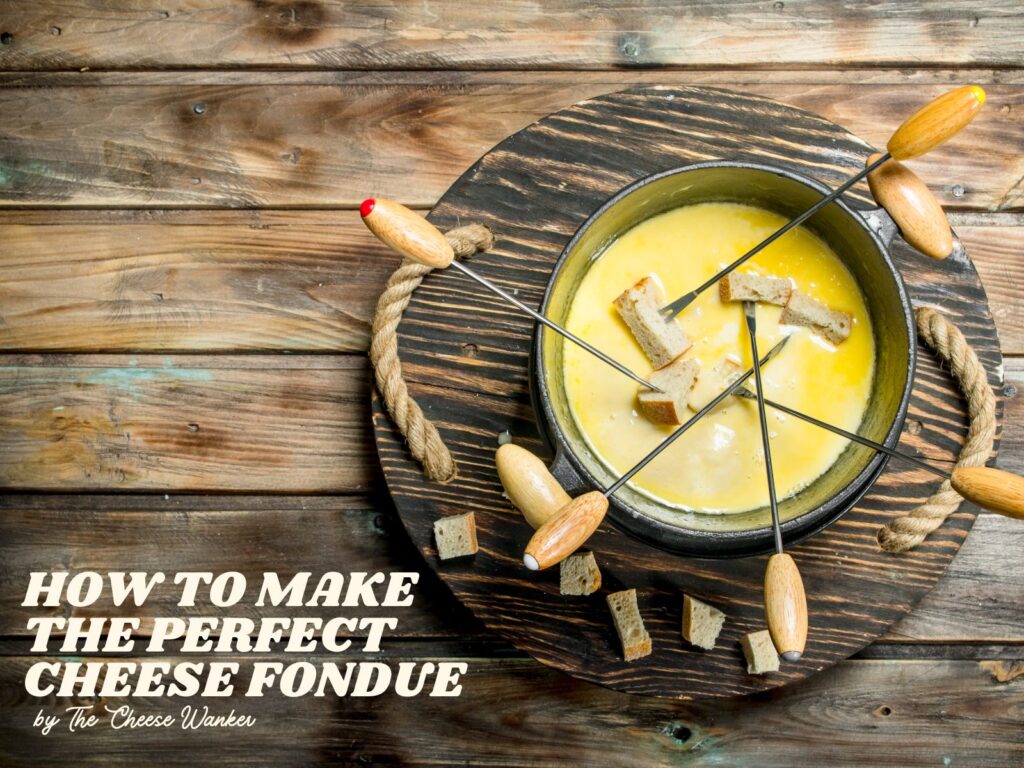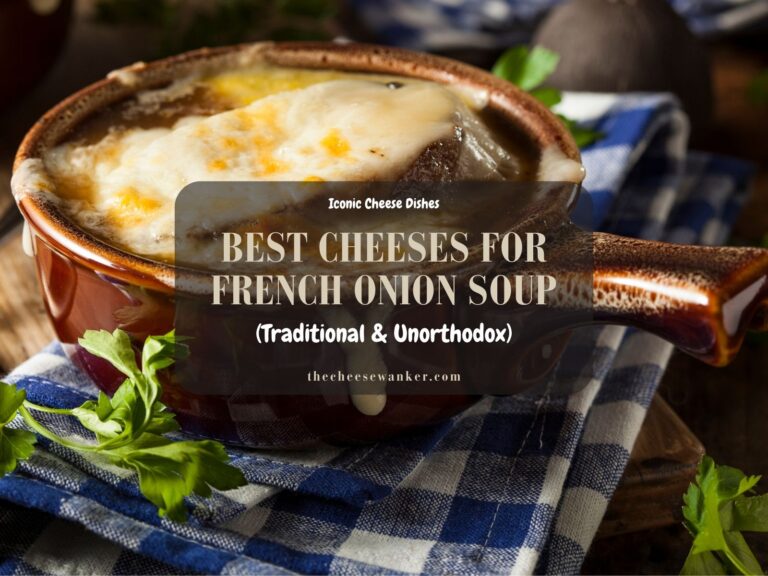Cheese fondue, with its rich, gooey goodness and communal dipping ritual, has been a beloved dish for generations. Creating the perfect cheese fondue involves a delicate dance of flavours and textures that can elevate a simple gathering into a memorable feast. In this blog post, we’ll delve into the key considerations and techniques to master the art of crafting the perfect cheese fondue experience.

[Disclaimer: This post contains affiliate links. If you use these links to make a purchase, we may earn a commission (at no cost to you)]
SEE ALSO: Our extensive list of the most iconic cheese dishes from all around the world →
History of cheese fondue
Originating in the Swiss Alps, fondue has a rich history that transcends its culinary appeal. Originating in the 18th century as a practical solution for Alpine communities during harsh winters, fondue was a way to make the most of local cheeses like Gruyère and Emmental.
Initially a survival meal, it evolved into a communal experience, symbolising Swiss hospitality. By the mid-20th century, fondue had spread globally, becoming a centrepiece for social gatherings and celebrations.
Today, while traditional recipes endure, modern variations showcase the dish’s adaptability. As we delve into crafting the perfect cheese fondue, we honour its Alpine beginnings and the timeless legacy of a dish that seamlessly blends history, culture, and culinary excellence.
What makes the perfect cheese fondue?
Of course, it takes a multi-faceted approach to craft the ultimate fondue. But fret not, we’ve got all the tips you will need to know. Let’s delve into cheese, secret ingredients and fool-proof strategies.
Choosing the right combination of cheeses
At the heart of crafting the perfect cheese fondue lies a crucial decision: the selection of cheeses. The alchemy of flavours in fondue hinges on creating a harmonious blend that balances richness, creaminess and depth.
Traditional Swiss fondue typically incorporates Gruyère and Emmentaler, two cheeses with distinct characteristics that complement each other beautifully.
Gruyère
Known for its nutty and slightly sweet flavour profile, Gruyère brings a depth of taste that forms the backbone of many classic fondue recipes. Its smooth melting quality contributes to the velvety texture that fondue enthusiasts cherish. As Gruyère melts, it releases a luscious creaminess that binds the fondue together.
Emmentaler (or French Emmental)
Adding another layer to the flavour symphony is Emmentaler, prized for its mild, nutty taste and characteristic holes. This cheese contributes a delightful stringiness to the fondue, creating that quintessential “cheese pull” as you dip your bread or other accompaniments.
Moreover, its melting properties enhance the overall texture, ensuring a satisfying and cohesive fondue experience.
Exploring variations
While Gruyère and Emmentaler form the classic foundation, don’t shy away from exploring variations. Consider incorporating an aged Cheddar for an extra layer of complexity or experimenting with other regional cheeses that boast distinct flavour profiles. Some great examples are Appenzeller, Vacherin Fribourgeois and Fontina.
This customisation allows you to tailor the fondue to your palate while maintaining the dish’s essence.
Avoiding pre-shredded cheese
To achieve the desired consistency and texture in your fondue, it’s advisable to steer clear of pre-shredded cheese. These products often contain anti-caking agents that can interfere with the smooth melting process.
Instead, choose freshly grated cheese, ensuring that each strand contributes to the fondue’s luxurious texture. You can read more about why you should grate your own cheese here.
Furthermore, you can experiment with ratios until you find the perfect harmony. And don’t be afraid to get creative with your cheese selections to personalise the flavour profile of your fondue.
Which types of pot are best for fondue?
Selecting the right pot for your cheese fondue is a crucial decision with a significant impact on your culinary adventure. Consider these key factors.
Material: Opt for stainless steel or enamelled cast iron for efficient heat distribution.
Size: Choose a pot that matches your serving quantity, allowing for easy stirring and even heating.
Compatibility with heat source: Ensure the pot is suitable for your chosen heat source—stovetop burners, gel fuel or electric elements.
Non-stick convenience: A non-stick coating aids in easy stirring and cleaning for a smooth fondue experience.
Fork rests and stability: Look for integrated fork rests and a stable base to enhance safety and prevent spills.
Aesthetic appeal: Lastly, balance functionality with aesthetics, choosing a pot that complements the style of your gathering.
These are three of our favourite fondue pots:
Swissmar Lugano Cheese Fondue: Made for entertaining, this retro 70’s throwback is the ultimate entertaining tool. The Lugano cast iron pot is shaped like a traditional Swiss caquelon, making it perfect for cheese fondue.
Boska Cheese Fondue Party Set: With fondue pan, fondue forks and tea lights, you have everything you need to start a delicious cheese fondue (or chocolate fondue).
Artestia 2.11-Quart Ceramic Fondue Pot Set: We’ve left the most stylish for last with this Artestia fondue put. It features a Swiss Alps pattern designed that allows you to create an elegant centrepiece for your table setting.
How to use garlic in fondue
In the quest for the perfect cheese fondue, the role of garlic is not just a seasoning but an aromatic essential. Initiating the garlic infusion involves gently rubbing the fondue pot’s interior with a cut garlic clove, imparting a subtle yet distinctive essence to the dish.
For a bolder garlic presence, consider adding minced garlic directly to the fondue mixture, adjusting the quantity to personal taste. The key is to strike a harmonious balance, ensuring the garlic enhances without overpowering the cheese’s delicate flavours.
The allure of garlic lies in its ability to add depth without stealing the spotlight. As it melds with the melting cheese and wine, it creates a symphony of flavours, elevating the fondue experience.
Feel free to experiment, customising the garlic infusion to suit your taste and that of your dining companions.
Enhancing fondue texture with cornstarch
In the pursuit of the ideal cheese fondue, cornstarch plays a crucial role in achieving a flawless texture. Before introducing cheese to the pot, a light coating of cornstarch serves as a safeguard against clumping, ensuring a smooth and velvety fondue.
This unassuming thickening agent works behind the scenes, creating a stable suspension as the cheese melts. It prevents undesirable lumps and allows for a luxurious, silky consistency. Precision is key, as a light touch is sufficient, and excessive use may result in a chalky texture.
Cornstarch also offers a quick fix for consistency issues. If the fondue is too thin, a cornstarch slurry can be added, while a touch more wine can be introduced to thin out a too-thick mixture.
Choosing the perfect wine for fondue
Next, the choice of wine is not merely a cooking ingredient—it’s a key player in elevating the dish’s flavours. By opting for a dry white wine, such as Sauvignon Blanc or Swiss white varietals, you will complement the cheese without overshadowing its richness.
The selected wine serves as a partner in the fondue alchemy, enhancing the overall experience. Pour it gradually into the melting cheese, allowing it to weave its way through the cheese blend. The wine’s acidity cuts through the richness, contributing to a balanced and nuanced fondue.
Once again, experimentation is encouraged, but ensure the wine harmonises with the cheese selection.
The secret Swiss ingredient: Kirschwasser
No discussion about the perfect cheese fondue is complete without a nod to kirschwasser, a cherry brandy that adds a subtle yet distinctive touch of elegance. Originating from Switzerland, this spirit brings a nuanced sweetness and a hint of fruitiness to the fondue experience.
Traditionally, a small amount of kirsch is added towards the end of the fondue preparation, infusing the dish with a gentle warmth and a touch of complexity. Its role goes beyond flavour, as kirsch also aids in preventing the cheese from becoming overly stringy, ensuring a smooth and delightful texture.
Adding a touch of acidity
Furthermore, the addition of acidity, whether from a splash of lemon juice or white wine vinegar, is a masterstroke. Beyond its role in balancing richness, acidity introduces a refreshing quality, preventing the cheese from overwhelming the palate.
This element also adds complexity, enhancing the overall flavour profile and preventing clumping for a smooth texture.
Practically, acidity engages with the proteins, maintaining the emulsified state of the cheese. This not only contributes to the fondue’s luscious texture but also brings an exciting element to the communal dining experience.
How to season your fondue to perfection
Next, the seasoning duo of nutmeg and pepper plays a starring role, adding depth and a subtle kick to the overall flavour profile.
Nutmeg
Grating in fresh nutmeg infuses the fondue with warm, aromatic notes, creating an elegant layer of complexity. The fragrant spice subtly marries with the richness of the cheese, offering a delightful and sophisticated touch to each dip.
Black pepper
A pinch of black pepper or a dash of cayenne pepper contributes a well-balanced kick, enhancing the fondue’s overall depth. The spice introduces a subtle heat that complements the creaminess of the cheese.
Of course, the key lies in achieving a balanced harmony between the nutmeg’s aromatic warmth and the pepper’s subtle heat. This symphony of flavours adds a sensory dimension to the fondue, transforming each bite into a culinary revelation.
Which type of bread should you use?
Choosing the right bread for cheese fondue is crucial for an exceptional dining experience.
Variety: Select a mix of breads like rustic baguette, rye or sourdough for diverse textures and flavours.
Bite-sized pieces: Cut bread into bite-sized cubes to ensure easy dipping and a generous cheese coating.
Crust and crumb balance: Select bread with a mix of crusty exterior and soft interior for a satisfying interplay of textures.
Day-old bread: Consider day-old bread for a firmer texture, preventing sogginess when dipped into warm cheese.
Gluten-free options: Explore quality gluten-free bread alternatives for inclusive dining experiences.
Flavoured bread: Experiment with bread varieties containing herbs or seeds to add an extra layer of flavour.
Best technique for making cheese fondue
In the delicate art of make the perfect cheese fondue, the technique of stirring plays a masterful role. It’s not just a simple task but a precise dance that ensures the even distribution of heat and the creation of a lusciously smooth texture.
Figure-eight movements
Engage in a figure-eight stirring pattern when melding your cheese mixture. This deliberate motion prevents clumping and encourages a gradual, seamless integration of the cheeses with the liquid components.
The figure-eight ensures that every part of the pot is covered, leaving no room for uneven melting.
Continuous motion
Consistency is key when it comes to stirring. A continuous, steady movement prevents the cheese from sticking to the bottom of the pot and promotes a homogeneous blend. Take your time with this step, allowing the cheeses to melt gradually and meld into a velvety consistency.
Use a wooden spoon
Next, you will want to use a wooden spoon, as it distributes heat evenly and won’t scratch the surface of your pot. Also, the natural properties of wood contribute to the fondue’s overall flavour profile, imparting a subtle warmth that complements the dish.
Be patient
Masterful stirring requires patience. Resist the temptation to rush the process, as allowing the cheese to melt gradually ensures a silky fondue texture. The slow dance of the cheeses becoming one with the wine and other ingredients is what makes the fondue experience truly exceptional.
Adjustments along the way
While stirring, observe the fondue’s consistency. If it seems too thick, a gentle addition of more wine can help achieve the desired liquidity. Conversely, if it appears thin, a small mixture of cornstarch or flour with wine can be introduced gradually, adjusting as needed.
The goal here is to achieve a texture that’s not only smooth but also fork-friendly. The cheeses should cling effortlessly to your chosen dippers, creating a delightful and satisfying experience with each dip.
Sodium citrate: a modern addition
Beyond the classic components of cheese fondue, another secret ingredient can elevate your culinary adventure: sodium citrate. This magical compound acts as an emulsifier, ensuring a smooth and velvety fondue consistency. Its ability to prevent the cheese proteins from clumping or breaking makes it a game-changer in the pursuit of fondue perfection.
You can read all about this mysterious ingredient in our dedicated blog post on how to use sodium citrate in cheese sauce.
Ingredients for a masterful cheese fondue (8 serves)
- 450 g Gruyère cheese, grated
- 300 g Emmentaler cheese, grated
- 1 tablespoon cornstarch
- 1 clove garlic, cut in half
- 1 cup dry white wine (Swiss white wine or Sauvignon Blanc)
- 1 tablespoon kirsch
- A pinch of nutmeg, freshly grated
- A pinch of black pepper
- 1 teaspoon lemon juice or white wine vinegar
- 1/2 teaspoon sodium citrate (optional, for added smoothness)
- 1 French baguette, rustic rye or sourdough, cut into bite-sized cubes
Step-by-step instructions
- Rub the inside of the fondue pot with the cut sides of the garlic clove.
- Toss the grated Gruyère and Emmental with the cornstarch.
- Pour the wine into the fondue pot and heat it gently on the stove.
- Introduce lemon juice or white wine vinegar for a touch of acidity.
- Gradually add the cheese mixture, stirring continuously in a figure-eight pattern.
- Keep stirring until the cheese is fully melted and the mixture is smooth.
- If needed, adjust the heat to maintain a gentle simmer.
- Add the kirsch and continue stirring.
- Grate in a pinch of nutmeg and black pepper, adjusting to taste.
- If using sodium citrate, add it now and stir until fully incorporated. You can find instructions on how to use sodium citrate here.
- Once the fondue is smooth and velvety, transfer the pot to the fondue burner.
- Set up the fondue forks and arrange the bite-sized bread cubes for dipping.
- Dive into the communal experience of cheese fondue, ensuring each dip is coated in the luscious blend.
Conclusion
In our exploration of the art of cheese fondue, we’ve unveiled the secrets to transforming a simple dish into a gastronomic masterpiece. From the perfect cheese blend and choice of pot to the nuances of seasoning and the rhythmic dance of stirring, every element plays a crucial role.
As you embark on your fondue adventures, whether sticking to tradition or embracing creative twists, remember that the true magic lies in shared moments and the warmth of connection that a pot of cheese fondue brings.
Share your fondue tales and tips in the comments below. Let’s turn this post into a vibrant forum where fondue enthusiasts unite to exchange stories and recommendations. And the joy that only a communal pot of cheese fondue can bring.
Happy dipping!



